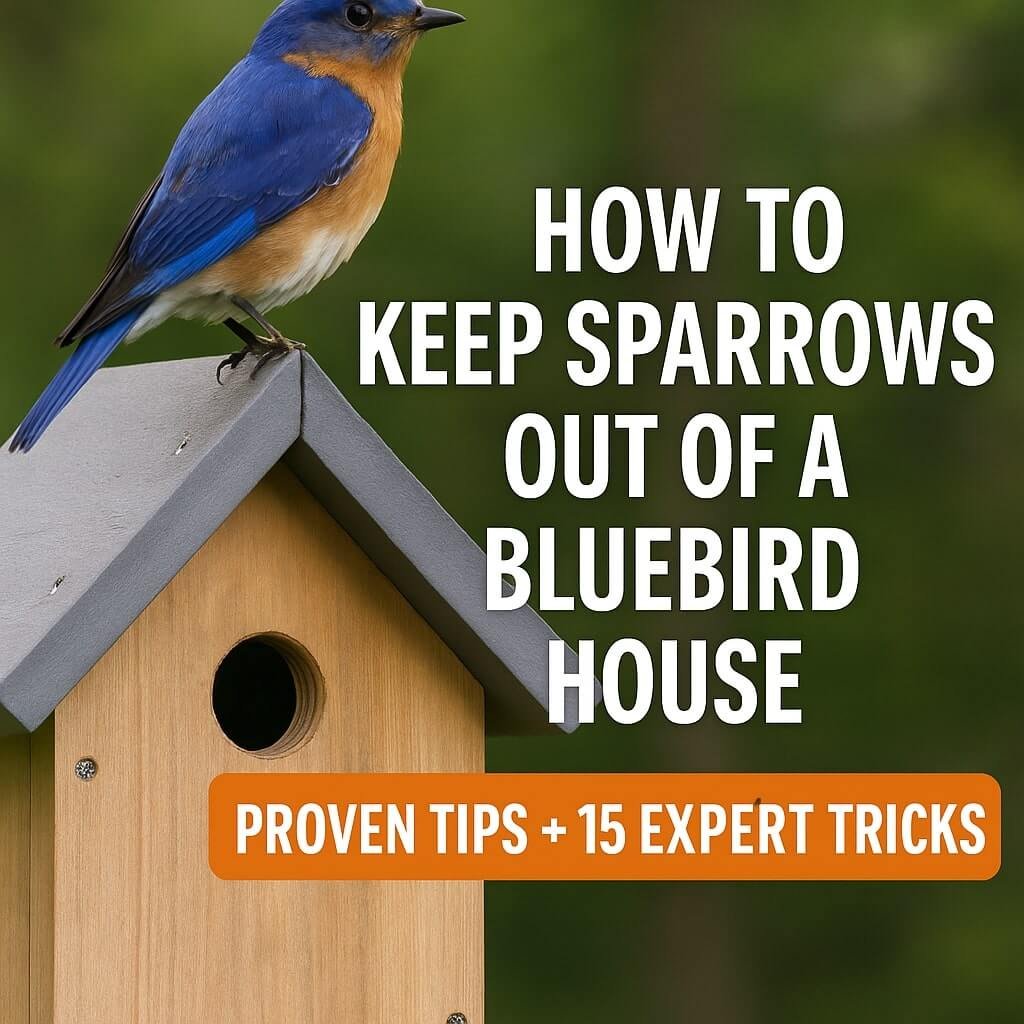Bluebirds are beloved songbirds known for their stunning colors, gentle nature, and important role in pest control. If you’ve installed a bluebird house hoping to host these cheerful birds, you might be dismayed to discover sparrows taking over. House sparrows, an invasive species, are notorious for their aggressive behavior and tendency to evict native birds. This guide provides proven methods and 15 expert tricks to help you keep sparrows out of a bluebird house, allowing your bluebirds to nest safely and thrive.
Why Sparrows Invade Bluebird Houses
Sparrows, particularly house sparrows (Passer domesticus), are cavity nesters just like bluebirds. They are highly adaptable and often seek out the same housing that attracts bluebirds. Unlike bluebirds, though, sparrows are aggressive and territorial, often attacking, killing, or driving out bluebirds and destroying their eggs.
The Threat House Sparrows Pose to Bluebirds
House sparrows aren’t just uninvited guests—they’re dangerous. These birds:
- Kill bluebird chicks and adults
- Destroy eggs
- Build nests on top of bluebird clutches
- Repeatedly return if not deterred
It’s crucial for anyone maintaining bluebird boxes to learn sparrow deterrent methods, as these invasions can devastate bluebird populations.
Key Characteristics of Sparrows vs. Bluebirds
| Feature | House Sparrow | Bluebird |
|---|---|---|
| Size | 5.5–6.3 inches | 6.5–8.5 inches |
| Behavior | Aggressive, territorial | Passive, territorial |
| Nest | Messy with paper, feathers | Neat, cup-shaped |
| Eggs | White, gray, or speckled | Pale blue (occasionally white) |
| Male Appearance | Gray cap, black throat | Bright blue with reddish breast |
Recognizing the species nesting in your box is essential before taking action.
15 Effective Strategies to Keep Sparrows Away
1. Use Proper Bluebird House Dimensions
A bluebird house should have:
- An entrance hole no larger than 1.5 inches (ideal for bluebirds, harder for sparrows)
- A floor size of about 5×5 inches
- Proper ventilation and drainage
Avoid larger openings that allow sparrows easy access.
2. Avoid Feeding Sparrows Nearby
Don’t feed cracked corn, bread, or white millet near bluebird houses—sparrows love them. Opt for mealworms and berries instead to attract bluebirds.
3. Remove House Sparrow Nests Promptly
If you see a messy, junk-filled nest in your bluebird box before eggs are laid, remove it immediately. Do this daily if necessary.
4. Install a Sparrow-Spooker
These lightweight devices use reflective tape or Mylar streamers above the house to deter sparrows. Surprisingly, bluebirds aren’t bothered by them once nesting begins.
5. Add a Monofilament Line
Fishing line can confuse or irritate sparrows as they approach the house. Attach strands around the entrance and roof, leaving the hole clear.
6. Use Slot-Style Entry Holes
Bluebirds prefer horizontal slot entrances, while sparrows find them less inviting. Houses with a 1.25″ high x 3.5″ wide slot deter sparrows effectively.
7. Change the House Location
Move the house 15–20 feet if sparrows continue to target it. Place it in a more open area, away from buildings and brush where sparrows tend to gather.
8. Block Off Problematic Houses Temporarily
If sparrows persist, cover or temporarily block the entrance. This breaks the cycle and gives bluebirds a chance to reclaim it later.
9. Avoid Multiple Birdhouses Close Together
Placing houses too close together encourages territorial disputes. Keep houses 100 yards apart to prevent sparrow domination.
10. Monitor Daily During Nesting Season
Check your bluebird boxes every day, especially during early spring. Remove sparrow nests early before eggs are laid.
11. Use a Van Ert Sparrow Trap (Carefully)
This trap captures sparrows inside the box without harming them. Check every 1–2 hours to release bluebirds if accidentally trapped.
12. Avoid Offering White Millet or Bread
Feeding stations should only provide food bluebirds like—mealworms, suet, or fruits—not high-carb grains sparrows love.
13. Install Predator Guards
These baffles or stovepipe guards prevent climbing animals—and sometimes aggressive sparrows—from gaining access to the box.
14. Relocate Sparrow Nesting Areas
Remove or block access to eaves, ledges, or vents where sparrows typically nest. Less competition means safer nesting for bluebirds.
15. Collaborate with Local Birding Communities
Birding forums and Facebook groups like Sialis.org offer region-specific tips and collective experiences for dealing with sparrow infestations.
Best Types of Bluebird Houses to Deter Sparrows
- Slot-style entrance
- Predator guards attached
- No perch (sparrows prefer perches)
- Painted light colors to reflect heat
- Mounted on poles rather than trees or fences
Common Mistakes That Attract Sparrows
- Using houses with large or round entry holes
- Placing feeders near nest boxes
- Allowing nesting material to accumulate
- Using decorative birdhouses with perches
- Not checking boxes frequently enough
Encouraging Native Bluebird Populations
Providing Food & Water Sources for Bluebirds
- Mealworms (live or dried)
- Berries: Elderberries, dogwood, serviceberries
- Clean water sources like shallow birdbaths
Creating a Safe Nesting Environment
- Open spaces with scattered trees
- Avoiding pesticide use
- Limiting artificial lighting at night
Legal and Ethical Considerations
House sparrows are not protected under the Migratory Bird Treaty Act, so nest removal and trapping are legal in most areas. However, humane practices and respect for native species should always guide your actions.
Recommended Tools and Accessories
| Tool | Purpose |
|---|---|
| Sparrow Spooker | Visual deterrent |
| Van Ert Trap | In-box sparrow trap |
| Slot Entry Box | Makes entry harder for sparrows |
| Predator Baffle | Prevents climbing threats |
| Birdhouse Camera | Monitors activity in real-time |
Real-Life Success Stories from Birders
Many bluebird enthusiasts report success with the sparrow-spooker + daily monitoring combo. Others swear by the monofilament method and trapping persistent sparrows. Combining multiple techniques provides the best results long-term.
FAQs
1. Can house sparrows and bluebirds coexist?
2. Are house sparrows protected by law?
3. Will a sparrow-spooker scare away bluebirds, too?
4. What time of year are sparrow invasions most common?
5. Should I use poison or glue traps?
6. How often should I monitor my bluebird boxes?
Conclusion
Keeping sparrows out of a bluebird house takes dedication, observation, and the right tools. From modifying the house structure to deploying deterrents like spookers and traps, every small step adds up to a safer home for your bluebirds. Bluebird conservation starts in your backyard—stay consistent, be observant, and never give up on your mission to protect these beautiful birds.




